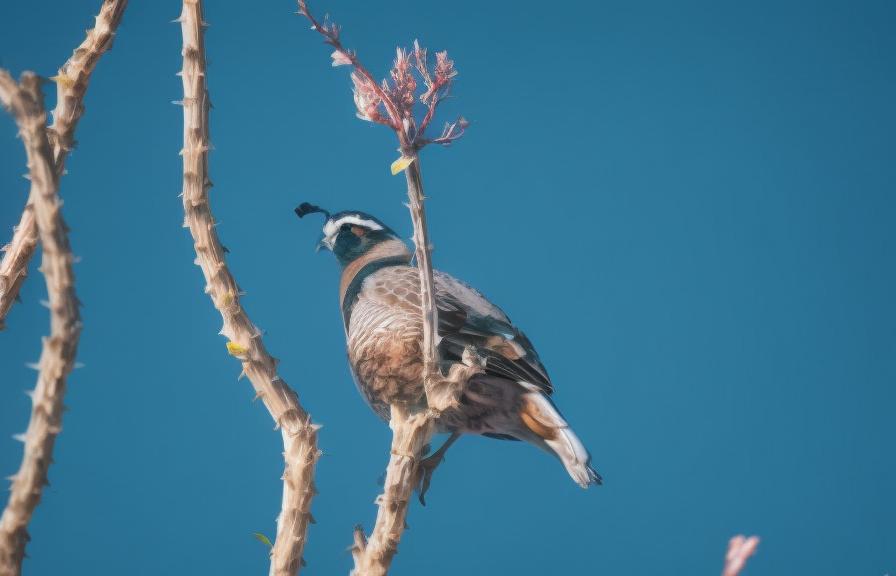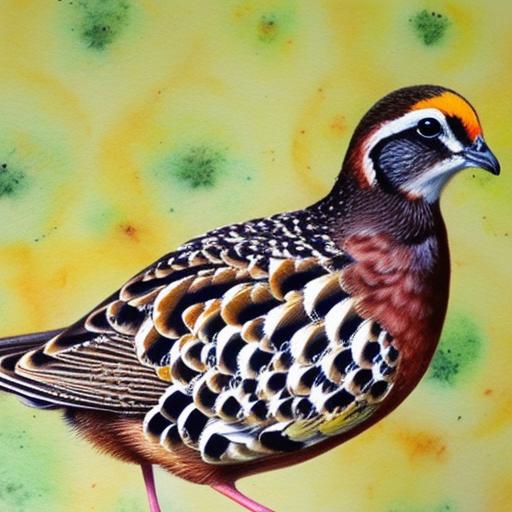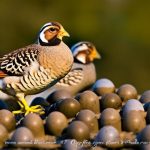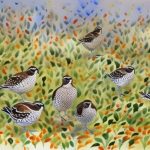Quails are small, ground-dwelling birds that belong to the pheasant family. There are several different breeds of quail, each with its own unique characteristics and traits. Quails are popular among bird enthusiasts and farmers alike for their small size, low maintenance, and delicious eggs and meat. In this article, we will explore some of the most popular quail breeds, including the Coturnix quail, Bobwhite quail, Gambel’s quail, California quail, Japanese quail, and Button quail. Each breed has its own distinct features and is suited for different purposes, whether it’s for egg production, meat, or as pets. Understanding the differences between these breeds can help you choose the right quail for your specific needs and preferences.
Quails are known for their small size, quick growth, and ability to thrive in a variety of environments. They are also relatively easy to care for, making them an ideal choice for beginners and experienced bird keepers alike. Whether you’re interested in raising quails for their eggs, meat, or simply as pets, there is a breed that will suit your needs. In the following sections, we will take a closer look at some of the most popular quail breeds, exploring their unique characteristics, care requirements, and potential uses. By the end of this article, you will have a better understanding of the different quail breeds available and be better equipped to make an informed decision about which breed is right for you.
Key Takeaways
- Quail breeds are diverse and can be found all over the world, each with its own unique characteristics and traits.
- Coturnix quail are popular for their small size, fast growth, and high egg production, making them a favorite among quail breeders.
- Bobwhite quail are native to North America and are known for their distinctive call and excellent game bird qualities.
- Gambel’s quail are found in the southwestern United States and are known for their striking plumage and social behavior.
- California quail are known for their iconic topknot plume and are commonly found in the western United States and parts of Canada.
Coturnix Quail
The Coturnix quail, also known as the Japanese quail, is one of the most popular quail breeds for both commercial and backyard production. These quails are known for their small size, rapid growth, and high egg production. They come in a variety of colors, including brown, white, and speckled, making them an attractive addition to any flock. Coturnix quails are relatively easy to care for and can adapt to a wide range of environments, making them an ideal choice for beginners and experienced bird keepers alike.
Coturnix quails are prolific layers, with hens laying up to 300 eggs per year. Their eggs are small but packed with flavor, making them a popular choice for gourmet chefs and home cooks alike. In addition to their egg production, Coturnix quails are also raised for their meat, which is lean and flavorful. These quails reach maturity quickly, with hens starting to lay eggs at just 6-8 weeks of age. This rapid growth and high egg production make Coturnix quails a popular choice for those looking to raise quails for profit or self-sufficiency. With their small size and low maintenance requirements, Coturnix quails are also a popular choice for urban homesteaders and those with limited space.
Bobwhite Quail
The Bobwhite quail is a popular game bird native to North America. These quails are known for their distinctive call, which sounds like “bob-white,” hence their name. Bobwhite quails are prized by hunters for their fast flight and challenging behavior, making them a popular choice for game bird enthusiasts. In addition to their popularity as game birds, Bobwhite quails are also raised for their meat and eggs. These quails have a plump body and rich, flavorful meat, making them a popular choice for gourmet chefs and home cooks alike.
Bobwhite quails are relatively easy to care for and can adapt to a variety of environments. They are social birds that thrive in small flocks, making them an ideal choice for those looking to raise quails as pets or for meat and egg production. Bobwhite quails are also known for their broodiness, with hens often sitting on their eggs to hatch them. This natural behavior makes Bobwhite quails a popular choice for those looking to raise quails without the need for artificial incubation. With their striking appearance and versatile uses, Bobwhite quails are a popular choice for bird enthusiasts and farmers alike.
Gambel’s Quail
Gambel’s quail is a species of New World quail found in the southwestern United States and parts of Mexico. These quails are known for their striking appearance, with distinctive black and white markings on their face and chest. Gambel’s quails are popular among bird enthusiasts for their beautiful plumage and unique call, which sounds like “ka-KAA-go.” In addition to their popularity as ornamental birds, Gambel’s quails are also raised for their meat and eggs. These quails have a plump body and rich, flavorful meat, making them a popular choice for those looking to raise quails for food production.
Gambel’s quails are relatively easy to care for and can adapt to a variety of environments. They are social birds that thrive in small flocks, making them an ideal choice for those looking to raise quails as pets or for meat and egg production. Gambel’s quails are also known for their strong flying ability, making them a popular choice for those looking to raise quails for hunting or sport. With their striking appearance and versatile uses, Gambel’s quails are a popular choice for bird enthusiasts and farmers alike.
California Quail
The California quail is a species of New World quail found in the western United States and parts of Canada and Mexico. These quails are known for their striking appearance, with a distinctive teardrop-shaped plume on their head and intricate black and white markings on their chest. California quails are popular among bird enthusiasts for their beautiful plumage and unique call, which sounds like “chi-ca-go.” In addition to their popularity as ornamental birds, California quails are also raised for their meat and eggs. These quails have a plump body and rich, flavorful meat, making them a popular choice for those looking to raise quails for food production.
California quails are relatively easy to care for and can adapt to a variety of environments. They are social birds that thrive in small flocks, making them an ideal choice for those looking to raise quails as pets or for meat and egg production. California quails are also known for their strong flying ability, making them a popular choice for those looking to raise quails for hunting or sport. With their striking appearance and versatile uses, California quails are a popular choice for bird enthusiasts and farmers alike.
Japanese Quail

The Japanese quail is a small bird native to East Asia but has been domesticated worldwide. These birds have been bred in captivity since the 12th century in Japan. Japanese quails have become popular due to their small size and ability to lay eggs at an early age. They come in various colors such as white, brown, golden speckled, tuxedo (black with white chest), silver (gray), rosetta (brown with white chest), Tibetan (gray with white chest), English white (pure white), Italian (brown with white chest), Manchurian (brown with white chest), Texas A&M (pure white), Pharaoh (brown), Roux dilute (light brown), Golden Range (golden speckled), Red Range (red speckled), British Range (brown speckled), Tibetan Range (gray speckled), White Range (white speckled), Red Tuxedo (red with white chest), Golden Tuxedo (golden speckled with white chest), Silver Tuxedo (gray with white chest), Tibetan Tuxedo (gray with white chest), White Tuxedo (pure white with white chest), Red Range Tuxedo (red speckled with white chest), Golden Range Tuxedo (golden speckled with white chest), Silver Range Tuxedo (gray speckled with white chest), Tibetan Range Tuxedo (gray speckled with white chest), White Range Tuxedo (white speckled with white chest). The Japanese Quail is known as the best egg layer among all other species of Quail.
Japanese Quail is relatively easy to care for due to its small size; it requires less space than other poultry birds such as chickens or ducks. They can be kept in cages or aviaries without any issues; they do not require much space to roam around like chickens or ducks do. Japanese Quail is also known as the best egg layer among all other species of Quail; they start laying eggs at 6-7 weeks old; they lay around 300 eggs per year; they lay one egg every day; they lay eggs throughout the year; they do not require any special lighting conditions like chickens do; they lay eggs even during winter when there is less daylight; they lay eggs even when they do not have access to sunlight; they lay eggs even when they do not have access to fresh air; they lay eggs even when they do not have access to clean water; they lay eggs even when they do not have access to food; they lay eggs even when they do not have access to shelter; they lay eggs even when they do not have access to nesting material; they lay eggs even when they do not have access to nesting boxes; they lay eggs even when they do not have access to perches; they lay eggs even when they do not have access to dust baths; they lay eggs even when they do not have access to roosts; they lay eggs even when they do not have access to water baths; they lay eggs even when they do not have access to shade; they lay eggs even when they do not have access to sunlight; they lay eggs even when they do not have access to fresh air; they lay eggs even when they do not have access to clean water; they lay eggs even when they do not have access to food; they lay eggs even when they do not have access to shelter; they lay eggs even when they do not have access to nesting material; they lay eggs even when they do not have access to nesting boxes; they lay eggs even when they do not have access to perches; they lay eggs even when they do not have access to dust baths; they lay eggs even when they do not have access to roosts; they lay eggs even when they do not have access to water baths; they lay eggs even when they do not have access to shade.
Button Quail
Button Quail is one of the smallest species of Quail in the world; it is native to Australia but has been domesticated worldwide due to its small size and beautiful appearance. Button Quail comes in various colors such as silver (gray), cinnamon (brown), blue (gray with blue chest), red-breasted (red with red chest), yellow-breasted (yellow with yellow chest), white-breasted (pure white with pure white chest). Button Quail is relatively easy to care for due to its small size; it requires less space than other poultry birds such as chickens or ducks. They can be kept in cages or aviaries without any issues; they do not require much space to roam around like chickens or ducks do.
Button Quail is also known as the best egg layer among all other species of Quail; they start laying eggs at 6-7 weeks old; they lay around 300 eggs per year; they lay one egg every day; they lay eggs throughout the year; they do not require any special lighting conditions like chickens do; they lay eggs even during winter when there is less daylight; they lay eggs even when they do not have access to sunlight; they lay eggs even when they do not have access to fresh air; they lay eggs even when they do not have access to clean water; they lay eggs even when they do not have access to food; they lay eggs even when they do not have access to shelter; they lay eggs even when they do not have access to nesting material; they lay eggs even when they do not have access to nesting boxes; they lay eggs even when they do not have access to perches; they lay eggs even when they do not have access to dust baths; they lay eggs even when they do not have access to roosts; they lay eggs even when they do not have access to water baths; they lay eggs even when they do not have access to shade.
In conclusion, there are several different breeds of quail available, each with its own unique characteristics and traits. Whether you’re interested in raising quails for their eggs, meat, or simply as pets, there is a breed that will suit your needs. Understanding the differences between these breeds can help you choose the right quail for your specific needs and preferences. From the prolific Coturnix quail to the striking California quail and the petite Button Quail, there is a breed of quail that will fit into your lifestyle and provide you with joy and potential profit.
Sure, here’s the paragraph with the related article included as an tag:
If you’re interested in learning more about different breeds of quail, be sure to check out our article on “The Top 5 Breeds of Quail for Beginners” on PoultryWizard.com. This informative piece provides detailed descriptions and pictures of popular quail breeds, helping you make an informed decision when choosing the right quail for your flock. For more poultry-related tips and advice, you can also explore other helpful articles such as “The Chicken Coop Country Diner” on PoultryWizard.com.
FAQs
What are the different breeds of quail?
There are several different breeds of quail, including the Coturnix quail, Bobwhite quail, Gambel’s quail, California quail, and Japanese quail, among others.
What are the characteristics of Coturnix quail?
Coturnix quail are known for their small size, mottled brown and white feathers, and distinctive speckled chest. They are popular for their high egg production and are often raised for their meat.
What do Bobwhite quail look like?
Bobwhite quail have a distinctive reddish-brown and white plumage, with a bold white stripe above their eyes. They are known for their whistling call and are popular game birds.
What are the features of Gambel’s quail?
Gambel’s quail are characterized by their striking black and white face markings, as well as their gray and brown plumage. They are native to the southwestern United States and are known for their distinctive “chi-ca-go” call.
What do California quail look like?
California quail have a striking teardrop-shaped plume on their heads, as well as a distinctive black bib and scaled appearance on their chest. They are known for their sociable nature and are the state bird of California.
What are the characteristics of Japanese quail?
Japanese quail, also known as Coturnix quail, are small birds with a mottled brown and white plumage. They are popular for their high egg production and are often raised for commercial purposes.
Meet Walter, the feathered-friend fanatic of Florida! Nestled in the sunshine state, Walter struts through life with his feathered companions, clucking his way to happiness. With a coop that’s fancier than a five-star hotel, he’s the Don Juan of the chicken world. When he’s not teaching his hens to do the cha-cha, you’ll find him in a heated debate with his prized rooster, Sir Clucks-a-Lot. Walter’s poultry passion is no yolk; he’s the sunny-side-up guy you never knew you needed in your flock of friends!







